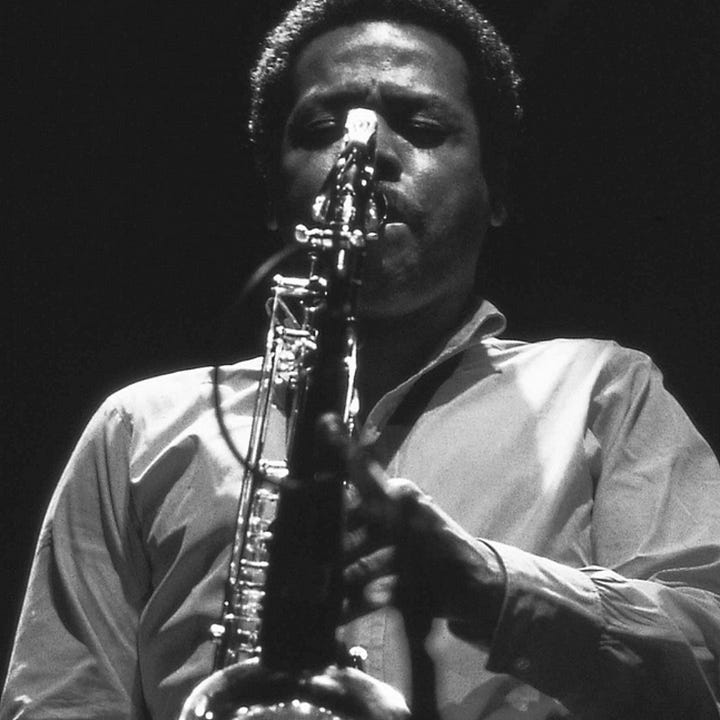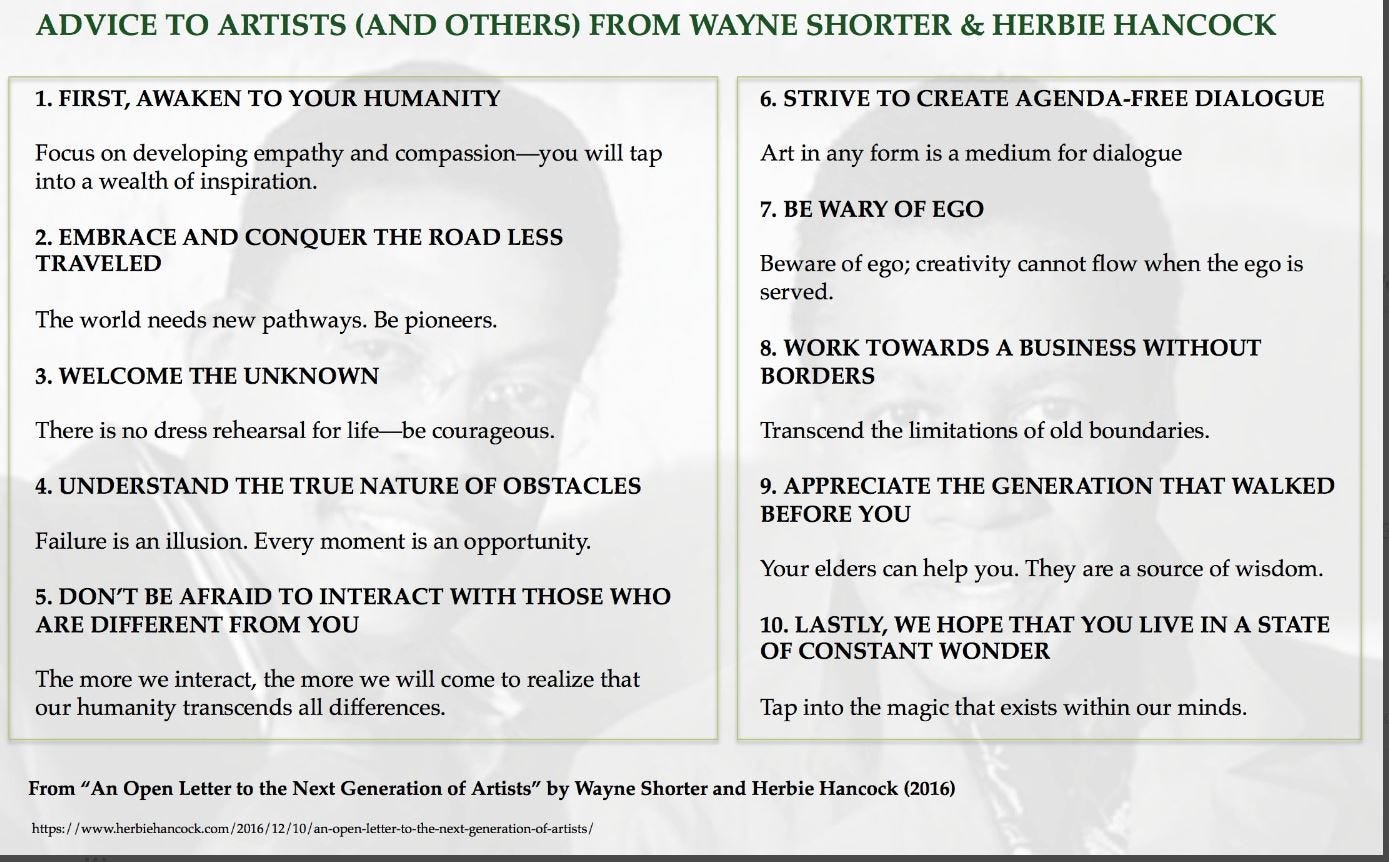Creative Artists and All That Other Jazz
Two of America's jazz greats share a letter to artists for a creative and peaceful planet


Jazz is this elusive art form that transforms music into mystical magic.
It’s a strange brew of elegant theory and organic creativity. I am not a heavy consumer of jazz; I just respect its complexity, serendipity and practitioners.
Even if you don’t listen to jazz, you know the names of these legendary musicians and singers: Miles Davis, John Coltrane, Billie Holiday, Louis Armstrong, Dave Brubeck, Charlie Parker, Ella Fitzgerald, Chic Corea and Thelonious Monk, among many others.
ADD LINKS TO YOUTUBE SONGS
In 2016, saxophonist, Wayne Shorter, and pianist, Herbie Hancock, wrote an “Open Letter to the Next Generation of Artists” (see highlights below), giving advice to creative artists (and anyone else too). They sought to encourage certain universal behaviors to transcend lives into art and action that matters.
LINKS TO SHORTER AND HANCOCK, WIKI OR YT
Shorter and Hancock believed that all of these separate and small actions are pieces of the puzzle that connect us all together to make an impact.
Insights and Takeaways From the Zen of Jazz
Artists usually give us insights into the craft, so this opportunity is different. We get to learn about the existential and transcendental attributes of master musicians.
As a creative person, I wanted to share my thoughts and takeaways from this “self-help” advice coming from a unique and talented source. As an observer of global manipulations, I want to put my ideas into the context of the commencing new world order.
The overarching aim of the letter is one reason this letter speaks to my soul. Despite all the horror and hardships - war, mass shootings and poverty - in the world, the authors ask you to seek beauty amid all the pain.
Constructive Force for Peace - Be “vehicles for the construction of peace” as opposed to ‘vehicles of destruction’ that stimulate the agony. This task requires that you find your unique mission in life to increase positivity to push against the negative tide.
Awaken to your humanity — Artists think beyond themselves. Shorter and Hancock realized that “we do not exist alone and we cannot create alone.” These jazz icons called for an awakening of humanity by actions “rooted in altruism and compassion.”
Creativity first opens up your soul, then it opens up your heart. It expresses the beauty of the human and physical world that allows compassion to creep in and flood the senses. These artistic endeavors help focus your energy and empower your empathy.
I love both science and creativeness. There is immense beauty and understanding in both. These two forces drive my humanity and lead my actions.
Take the road less traveled — This is a standard axiom that holds more purpose nowadays. The advent of the Internet, social media and corporate capture mean we are all subject to sameness. Diverging from the norm makes you an outsider. The pandemic and lockdowns ill-taught us that conformity is good.
Shorter and Hancock were prophetic when they said the “world needs new pathways” and “don’t be hijacked by common rhetoric or false beliefs and illusions” about how to live. Creativity offers endless avenues, repetition is a cul-de-sac. Music explores the dynamics of sound, while life searches for meaningful action in the spirit of pioneers.
I’ve followed alternative paths all my life. It wasn’t planned at all. It was part navigation and and part serendipity. My guiding principle is exploration to seek out experiences beyond ordinary boundaries.
Embrace the unknown — It’s not a surprise that jazz musicians relish the unknown. They spend careers exploring melodious pathways down uncharted aural roads. For them, the unknown necessitates “a creative process that is unparalleled in potential and fulfillment.” Jazz artists understand that in the past, present and future “everything is connected.”
Most of us fear the unknown. We like the safety of the comfort zone. Reaching into the unknown usually causes anxiety instead of excitement. Adventure requires enough courage to fulfill your destiny despite the hardships and obstacles of the past. If you lose “your sense of exhilaration and reverence for this wonderful world,” then the game is mostly over.
For me, the comfort zone offers a stagnant life. It’s a suffocating pond without any fresh oxygen. I embrace change and flow. Art pushes me to the edges of my existence.
Use the value of obstacles — Failure is an ill-conceived term. It gets way too much attention and credit as a negative element. Yet, failure is a positive force. Certainly jazz, along with other music genres, is an endless exercise in futility until you find the right rhythm and notes.
Shorter and Hancock posit the right attitude. “We have this idea of failure, but it’s not real, it’s an illusion.” They see failure as a “new opportunity … or a new canvas to create upon.” In reality, these crossroad moments are limitless with infinite possibilities.
The Obstacle is the Way is one of my favorite recent books. It unveiled the powerful insights of Stoic philosophy. It opened my mind to a new approach when dealing with obstacles. Failures are invaluable for making decisions, progress and moving forward.
Different is interesting — In music, being different may set you apart from the mainstream until they find you. Without differences we are left with the same old mush pretending to be tasty. Humans require fresh ideas and stimulation. We get bored when the newness wears off.
Being afraid to seek out those differences fails to push our personal boundaries. It prevents us from making empowering connections to those beyond normal borders. Shorter and Hancock believed that “the more we interact, the more we will come to realize that our humanity transcends all differences.”
I’ve witnessed tribal hatred, racism and ethnic anger across the globe. Seeing like humans on the other side leads to an “exchange of thoughtfulness and kindness.” The possibility of peace comes only by understanding the pain emanating from both sides.
Create dialogue, not agendas — “Art in any form is a medium for dialogue, which is a powerful tool.” Jazz music is a perfect amplifier for leaving agendas off the table. For the rest of us, an agenda-free approach is tough. Open dialogue requires open minds first.
Creativity is a self-help step to focus your energies on “reflecting and challenging the fears.” Only then do we discover our courage. A fatal flaw in the human condition is to control dialogue with a one-sided agenda.
Jazz speaks its own language with infinite interpretations. Shorter and Hancock sought to translate these qualities to tell stories about our mysteries and encourage the same in others.
Regulate your ego — Ego is the anti-force. It sucks up all the oxygen to leave a dead zone. It prevents ideas, progress and humans from reaching their full potential. Ego is a dead weight delivered as seasoned fuelwood.
Creativity is a free-form entity. It suffers from the restrictions and illusions of egocentric antics. A spotlight on status, with an arrogant attitude, only slows down the process that “cannot flow when only the ego is served.”
We all engage our egos. At best, it helps us to develop enough self-esteem to move ahead. At worst, it is parasitic to positive efforts and thwarts the goodwill of others to maintain relationships and make art.
Create a business beyond borders — The old music industry is rife with bad managers, scheming record labels and stolen artist revenue. Shorter and Hancock ask creative artists to look beyond traditional models and markets to increase their exposure. This added power is not a ploy for revenue, but a means to share more than just commercial art.
The real value of this ‘marketing advice’ is that it opens up the opportunity for “living with creative integrity (that) can bring forth benefits never imagined.”
A lot has changed since 2016. Traditional gatekeepers are falling every day. New platforms arise to replace outdated models. The global market is open to anyone with Internet access. Younger generations already thrive in the new marketplace. This is truly a revolution to older artists groomed on gateway access.
See through elder eyes — As the Boomer Generation gives way to Generations X, Y and Z, there are enormous changes occurring in mindsets, the workplace and life choices. The shift from traditional to optional is in full throttle. This transformation alters relationships, business models and opportunities, not to mention creativeness.
Jazz musicians honor traditions and those practitioners who preceded the current artists. Shorter and Hancock are just two examples of this highly respected heritage that has “weathered storms and endured the same heartbreak.”
Will old world advice still carry weight in a new world environment? In my opinion, though systems and dynamics are drastically changing now, there remains areas of weakness. Struggle provides clarity of mind and mettle. Elder experience is still a rich vein to draw upon.
Wallow in wonderment — Imagination does not deteriorate with age, it is affected by “sadness, prolonged struggle or social conditioning.” We lose the magic. If imagination fades, then life fades away too.
Musicians and other artists spend a lifetime striving to draw from the magic well. They fully understand that art is the ‘fountain of youth’ and that a keen imagination keeps them on a sharp edge.
Constant wonder fuels my life. It set the pace for my professional work in the environment, and now carries on with creative endeavors in semi-retired life. Shorter and Hancock nail the message when they ask us to “treasure and nurture” our imagination to always find yourself on the “precipice of discovery.”
Creative Conclusions
Creative artists are ageless. They only retire due to bad circumstances or by choice. The art inside doesn’t wane because the DNA is still the same. Outside forces alter the mission more so than the disappearance of the passion.
For example, Pablo Picasso and Georgia O’Keeffe painted late into their long lives. Grandma Moses just started painting in her 70s. The Rolling Stones and Paul McCartney are still selling out venues.
Sadly, Wayne Shorter passed away earlier this year at age 89. His death was the impetus for this essay. It led me to this Open Letter essay written with Hancock.
Shorter and Hancock are fully aware that the soul savors nourishment, at any age. I concur. They viewed creative arts as a means that can bring peace. “It begins with a cause. Your causes create the effects that shape your future and the future of those around you.”
For me, nothing is more on the mark than the above assertion. The environment was my umbrella cause. It spearheaded my direction into forestry school, agroforestry work in Kenya and the Sudan, and conservation and sustainability work in the rainforests of Southeast Asia.
That is what shaped my future, my friends and my entire life.
As I enter my mid-60s, there are two things that consume my thoughts. First, my professional work life is mostly over. This is a weird statement to swallow. Second, my creative efforts are now free to roam the wildlands of my imagination.
Writing essays and songwriting are now my final frontier landscapes.
I trust that I can respect the wishes of Shorter and Hancock to “be bold and tirelessly compassionate.”
Coda
As a tribute to the late Wayne Shorter and the indominable Herbie Hancock, please spend a minute or two to listen to these two legendary artists.
======================
If you like the songs and/or essays, please help me distribute them by sharing and following me on Twitter and Substack. I also use Instagram to document the journey and offer songwriting insights.
I appreciate your time, support and aid in this endeavor.
Except in special cases, my original songs are free to the public. Please be mindful that alterations for racist intent is not permitted. Be critical, not hateful.
(Wayne Shorter image credit: Chris Hakkens, CC BY 2.0)




